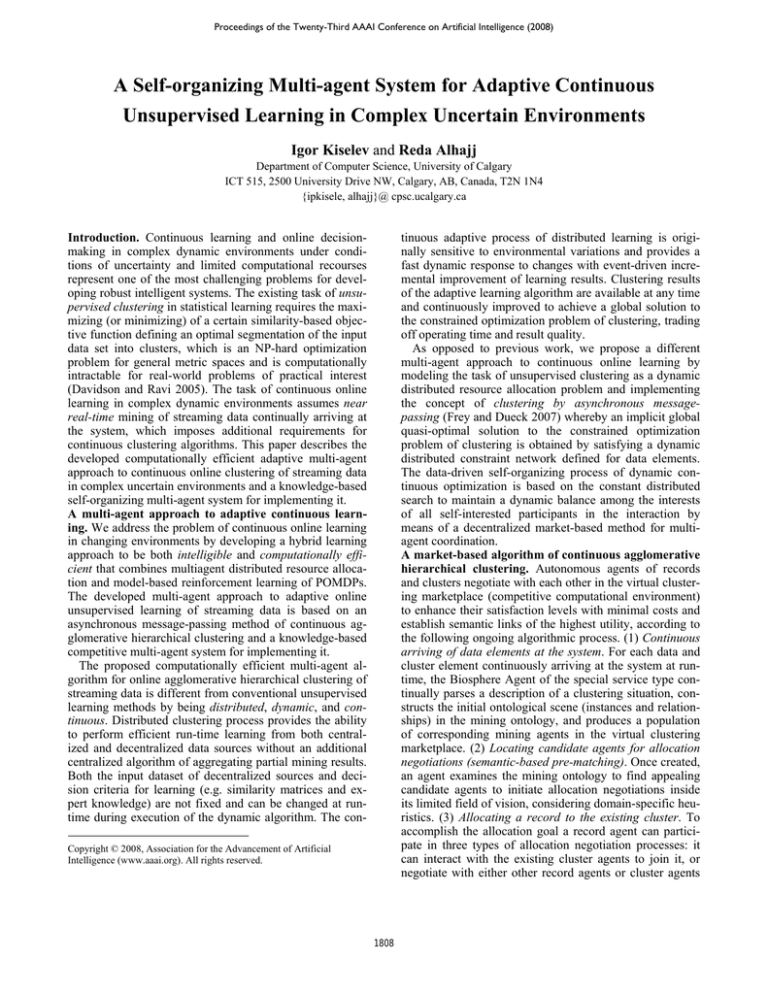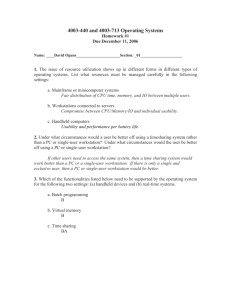
Proceedings of the Twenty-Third AAAI Conference on Artificial Intelligence (2008)
A Self-organizing Multi-agent System for Adaptive Continuous
Unsupervised Learning in Complex Uncertain Environments
Igor Kiselev and Reda Alhajj
Department of Computer Science, University of Calgary
ICT 515, 2500 University Drive NW, Calgary, AB, Canada, T2N 1N4
{ipkisele, alhajj}@ cpsc.ucalgary.ca
Introduction. Continuous learning and online decisionmaking in complex dynamic environments under conditions of uncertainty and limited computational recourses
represent one of the most challenging problems for developing robust intelligent systems. The existing task of unsupervised clustering in statistical learning requires the maximizing (or minimizing) of a certain similarity-based objective function defining an optimal segmentation of the input
data set into clusters, which is an NP-hard optimization
problem for general metric spaces and is computationally
intractable for real-world problems of practical interest
(Davidson and Ravi 2005). The task of continuous online
learning in complex dynamic environments assumes near
real-time mining of streaming data continually arriving at
the system, which imposes additional requirements for
continuous clustering algorithms. This paper describes the
developed computationally efficient adaptive multi-agent
approach to continuous online clustering of streaming data
in complex uncertain environments and a knowledge-based
self-organizing multi-agent system for implementing it.
A multi-agent approach to adaptive continuous learning. We address the problem of continuous online learning
in changing environments by developing a hybrid learning
approach to be both intelligible and computationally efficient that combines multiagent distributed resource allocation and model-based reinforcement learning of POMDPs.
The developed multi-agent approach to adaptive online
unsupervised learning of streaming data is based on an
asynchronous message-passing method of continuous agglomerative hierarchical clustering and a knowledge-based
competitive multi-agent system for implementing it.
The proposed computationally efficient multi-agent algorithm for online agglomerative hierarchical clustering of
streaming data is different from conventional unsupervised
learning methods by being distributed, dynamic, and continuous. Distributed clustering process provides the ability
to perform efficient run-time learning from both centralized and decentralized data sources without an additional
centralized algorithm of aggregating partial mining results.
Both the input dataset of decentralized sources and decision criteria for learning (e.g. similarity matrices and expert knowledge) are not fixed and can be changed at runtime during execution of the dynamic algorithm. The con-
tinuous adaptive process of distributed learning is originally sensitive to environmental variations and provides a
fast dynamic response to changes with event-driven incremental improvement of learning results. Clustering results
of the adaptive learning algorithm are available at any time
and continuously improved to achieve a global solution to
the constrained optimization problem of clustering, trading
off operating time and result quality.
As opposed to previous work, we propose a different
multi-agent approach to continuous online learning by
modeling the task of unsupervised clustering as a dynamic
distributed resource allocation problem and implementing
the concept of clustering by asynchronous messagepassing (Frey and Dueck 2007) whereby an implicit global
quasi-optimal solution to the constrained optimization
problem of clustering is obtained by satisfying a dynamic
distributed constraint network defined for data elements.
The data-driven self-organizing process of dynamic continuous optimization is based on the constant distributed
search to maintain a dynamic balance among the interests
of all self-interested participants in the interaction by
means of a decentralized market-based method for multiagent coordination.
A market-based algorithm of continuous agglomerative
hierarchical clustering. Autonomous agents of records
and clusters negotiate with each other in the virtual clustering marketplace (competitive computational environment)
to enhance their satisfaction levels with minimal costs and
establish semantic links of the highest utility, according to
the following ongoing algorithmic process. (1) Continuous
arriving of data elements at the system. For each data and
cluster element continuously arriving at the system at runtime, the Biosphere Agent of the special service type continually parses a description of a clustering situation, constructs the initial ontological scene (instances and relationships) in the mining ontology, and produces a population
of corresponding mining agents in the virtual clustering
marketplace. (2) Locating candidate agents for allocation
negotiations (semantic-based pre-matching). Once created,
an agent examines the mining ontology to find appealing
candidate agents to initiate allocation negotiations inside
its limited field of vision, considering domain-specific heuristics. (3) Allocating a record to the existing cluster. To
accomplish the allocation goal a record agent can participate in three types of allocation negotiation processes: it
can interact with the existing cluster agents to join it, or
negotiate with either other record agents or cluster agents
Copyright © 2008, Association for the Advancement of Artificial
Intelligence (www.aaai.org). All rights reserved.
1808
to create a new cluster to be allocated to (algorithmic steps
#3, #4, #5 respectively). (3.1) Requesting membership in a
cluster by a record agent (task announcement). A record
agent sends a membership request to selected cluster
agents. An autonomous agent of a candidate cluster can
proactively sends a membership proposal to an appealing
single record agent without receiving a membership request (algorithmic step #7). (3.2) Proposing membership in
a cluster by a cluster agent (bidding for allocation). A
cluster agent evaluates the value of the possible allocation
option (ontological relationship) with the partner according
to the agent criterion of the corresponding negotiation type
(“allocating a record to a cluster”). (3.3) Establishing a
membership contract by a record agent (allocation bid
processing). The record agent selects a single candidate
cluster agent with the most profitable allocation variant
that increases the value of its current agent state and sends
to it a membership contract. (3.4) Performing allocation of
a record to a cluster by a cluster agent (membership contract processing). Once a membership contract has been
awarded to a cluster agent, the initiator and participant of
the negotiation process commit to the target allocation goal
to establish a mutually profitable ontological relationship
and produce a new mining agent. (4) Creating a cluster by
record agents; (5) Creating a cluster of the higher level by
record and cluster agents. A record agent can consider the
option of creating a cluster of a higher level to be allocated
to with another record or cluster agent, in case there are
either no cluster agents that can increase the value of the
current state of a record agent or all of them refuse a membership request since such an allocation option is not profitable for them. (6) Creating a cluster of the higher level by
cluster agents. Besides negotiating with record agents to
enhance its quality, a cluster agent has the second goal of
establishing the most profitable allocation with the agents
of clusters. To achieve this goal a cluster agent participates
in a negotiation process of the synthesis type with other
cluster agents to create a cluster of a higher level to be a
part of it. (7) Agent proactive improvements of mining results. The agents exhibit not only reactive behavior by
simply responding to system events, but also proactively
search for the most profitable allocation variants and initiate negotiations to establish and reconsider ontological
relationships with other agents, thereby enhancing results
of the dynamic clustering process. During the active state
of agent proactive improvements, agents can restrictively
regulate a depth of their vision and consider allocation options with the increased length of the “ripple-effect”, which
is a decision reconsideration chain that improves the overall clustering results (adaptation). Additionally, different
centralized and distributed control mechanisms for selforganization are applied to control the transition of the
dynamic optimization process toward the global quasioptimal state while avoiding undesirable local attractors
(Kiselev et al. 2007). (8) Terminating algorithm execution.
For situations when no changes of ontological relationships
and cluster memberships can increase values of the agents,
the system eventually settles down to a new quasi-optimal
state and the distributed learning process turns to the inactive state. The algorithm is terminated either when a predefined amount of time elapses or it is known that the operating environment is static and no more input data elements
will arrive at the system.
Agent decision-making strategies. Goal-driven behavior
of autonomous agents is supported by the developed microeconomic multi-objective decision-making model,
which makes it possible for the learning algorithm to operate on the basis of nonstandard optimization criteria and to
be suitable for exploratory data analysis using unusual
measures of similarity. Currently supported agent decisionmaking strategies are based on the following agent criteria:
a distance-based measure of similarity, the Chebychev
similarity metric, and the angle metrics defining polarization (“shape”) of agent communities (multilevel and multicultural) in decision-space. Agent decision-making strategies can be applied dynamically at run-time to the whole
agent society (global level), to a single agent (individual
level), or to agent groups in different areas of the virtual
clustering marketplace (several polarization vectors).
Conclusion and future work. Conducted experiments
demonstrated the strong performance of the developed
multi-agent learning system for online hierarchical clustering of both synthetic datasets and datasets from the RoboCup Soccer and Rescue domains. Nevertheless, the developed system prototype revealed the current limitation of
the algorithm to efficiently perform massive data processing of high-dimensional data (gene expression datasets).
To address this issue we have been working on the approach to reducing the problem dimension while maintaining the essential characteristics of the original system (the
concept of renormalization) by modeling a multi-agent
system in incomplete decision space as decentralized partially observable Markov decision processes (DECPOMDPs) and applying Bayesian statistical methods. Additionally, further research is being conducted on extending
the adaptive learning approach to support online semisupervised classification by continuously deducing semantic-based classification rules from clustering results and
performing automatic rule-based classification at run-time.
References
Davidson, I., Ravi, S.S. 2005. Agglomerative Hierarchical
Clustering with Constraints: Theoretical and Empirical
Results. In Proceedings of the Ninth European Conference
on Principles and Practice of Knowledge Discovery in
Databases (PKDD 2005), LNCS Vol. 3721, 59–70. Berlin,
Germany: Springer Berlin-Heidelberg.
Frey, B. J., Dueck, D. 2007. Clustering by Passing Messages Between Data Points. Science 315: 972–976.
Kiselev, I., Glaschenko, A., Chevelev, A., Skobelev, P.
2007. Towards an adaptive approach for distributed resource allocation in a multi-agent system for solving dynamic vehicle routing problems. In Proceedings of the
Twenty-Second AAAI Conference on Artificial Intelligence
(AAAI-07), Student Abstract and Poster Program, 1874–
1875. Menlo Park, CA: AAAI Press.
1809



